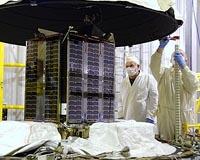 |
Hampton VA (SPX) Oct 22, 2009 An Earth observing satellite that provides new insight into the role that clouds and atmospheric aerosols play in regulating weather, climate, and air quality has hit its target two billion times. The Cloud-Aerosol Lidar and Infrared Pathfinder Satellite Observations (CALIPSO) mission, developed by NASA's Langley Research Center, Hampton, Va., and the French space agency Centre National d'Etudes Spatiales (CNES) has fired its lasers into the Earth's atmosphere over two billion times since its April 2006 launch. Along with passive infrared and visible imagers, CALIPSO's lidar, an advanced laser ranging technique, probes the vertical structure and properties of thin clouds and aerosols over the globe. This unique, high-resolution, top-to-bottom profile created from pulses of laser light is used by the international science community to better understand the complicated interaction of clouds and aerosols - one of the least understood processes in the Earth system. "The success of CALIPSO, as demonstrated in this significant milestone, is a credit to the entire team - from development to operation. It's been a truly remarkable global collaboration," said Pat Lucker, task lead and ground systems manager for CALIPSO. "As we work toward the next two billion shots, we are encouraged by the science community's enthusiastic response to our data." Because very few lasers of the type used on CALIPSO have been flown in the hostile environment of space, the satellite was designed and launched with two lidar units. The primary laser almost completed its three-year mission generating more than 1.6 billion pulses of light and 20 terabytes of data but had developed a slow leak in its pressure canister. The backup laser was switched on in early 2009 and nearly three years after launch, sent back its "first light" image on March 12. CALIPSO is a joint effort between NASA and CNES. NASA and Ball Aerospace designed the lidar instrument; CNES and Thales Alenia Space, previously Alcatel Space, built the Proteus satellite platform. Share This Article With Planet Earth
Related Links CALIPSO Space Technology News - Applications and Research
 Final Look At ESA's SMOS And Proba-2 Satellites
Final Look At ESA's SMOS And Proba-2 SatellitesParis, France (ESA) Oct 22, 2009 As preparations for the launch of SMOS and Proba-2 continue on schedule, the engineers and technicians at the Russian launch site say goodbye as both satellites are encapsulated within the half-shells of the Rockot fairing. Volker Liebig, ESA's Director of Earth Observation Programmes, said, "Today, with the encapsulation of the SMOS satellite in the launcher fairing, we have made an ... read more |
|
| The content herein, unless otherwise known to be public domain, are Copyright 1995-2009 - SpaceDaily. AFP and UPI Wire Stories are copyright Agence France-Presse and United Press International. ESA Portal Reports are copyright European Space Agency. All NASA sourced material is public domain. Additional copyrights may apply in whole or part to other bona fide parties. Advertising does not imply endorsement,agreement or approval of any opinions, statements or information provided by SpaceDaily on any Web page published or hosted by SpaceDaily. Privacy Statement |